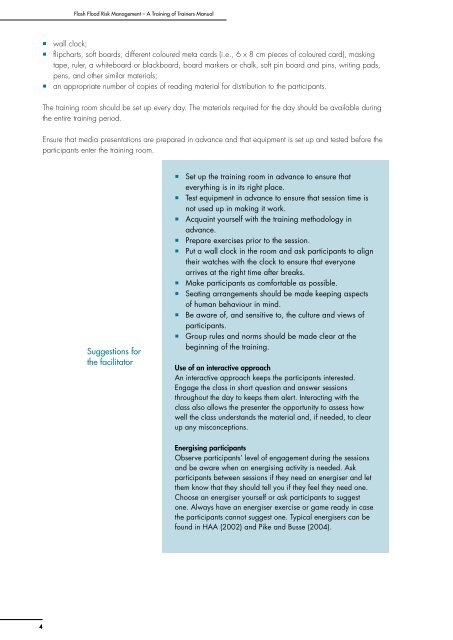Flash Flood Risk Management â A Training of Trainers ... - ReliefWeb
Flash Flood Risk Management â A Training of Trainers ... - ReliefWeb
Flash Flood Risk Management â A Training of Trainers ... - ReliefWeb
You also want an ePaper? Increase the reach of your titles
YUMPU automatically turns print PDFs into web optimized ePapers that Google loves.
<strong>Flash</strong> <strong>Flood</strong> <strong>Risk</strong> <strong>Management</strong> – A <strong>Training</strong> <strong>of</strong> <strong>Trainers</strong> Manual<br />
• wall clock;<br />
• flipcharts, s<strong>of</strong>t boards, different coloured meta cards (i.e., 6 x 8 cm pieces <strong>of</strong> coloured card), masking<br />
tape, ruler, a whiteboard or blackboard, board markers or chalk, s<strong>of</strong>t pin board and pins, writing pads,<br />
pens, and other similar materials;<br />
• an appropriate number <strong>of</strong> copies <strong>of</strong> reading material for distribution to the participants.<br />
The training room should be set up every day. The materials required for the day should be available during<br />
the entire training period.<br />
Ensure that media presentations are prepared in advance and that equipment is set up and tested before the<br />
participants enter the training room.<br />
Suggestions for<br />
the facilitator<br />
• Set up the training room in advance to ensure that<br />
everything is in its right place.<br />
• Test equipment in advance to ensure that session time is<br />
not used up in making it work.<br />
• Acquaint yourself with the training methodology in<br />
advance.<br />
• Prepare exercises prior to the session.<br />
• Put a wall clock in the room and ask participants to align<br />
their watches with the clock to ensure that everyone<br />
arrives at the right time after breaks.<br />
• Make participants as comfortable as possible.<br />
• Seating arrangements should be made keeping aspects<br />
<strong>of</strong> human behaviour in mind.<br />
• Be aware <strong>of</strong>, and sensitive to, the culture and views <strong>of</strong><br />
participants.<br />
• Group rules and norms should be made clear at the<br />
beginning <strong>of</strong> the training.<br />
Use <strong>of</strong> an interactive approach<br />
An interactive approach keeps the participants interested.<br />
Engage the class in short question and answer sessions<br />
throughout the day to keeps them alert. Interacting with the<br />
class also allows the presenter the opportunity to assess how<br />
well the class understands the material and, if needed, to clear<br />
up any misconceptions.<br />
Energising participants<br />
Observe participants’ level <strong>of</strong> engagement during the sessions<br />
and be aware when an energising activity is needed. Ask<br />
participants between sessions if they need an energiser and let<br />
them know that they should tell you if they feel they need one.<br />
Choose an energiser yourself or ask participants to suggest<br />
one. Always have an energiser exercise or game ready in case<br />
the participants cannot suggest one. Typical energisers can be<br />
found in HAA (2002) and Pike and Busse (2004).<br />
4

















